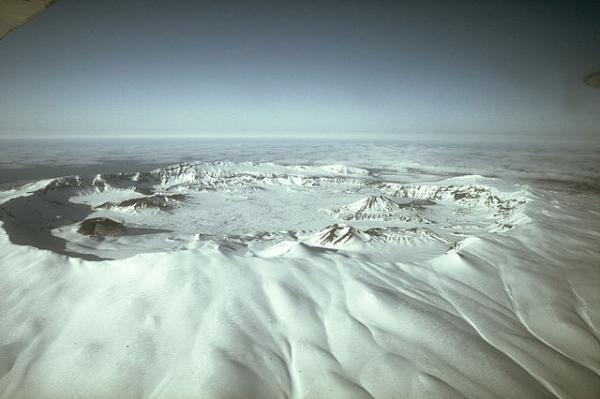Volcanic eruptions can alter our climate for months or years. Probably the most well-known of these is the eruption of Mt. Tambora in 1815, which gave us not only pretty sunsets but colder winters and summers. The stormy weather of that summer is the setting in which Mary Shelley wrote Frankenstein, and the far colder, snowy winters are said to have been the inspiration for much of the bad London climate that Charles Dickens describes in his work. In a new study, researchers have tried to connect an earlier volcanic eruption with events that might well have destabilized Caesar’s Roman Republic and Cleopatra’s Ptolemaic Kingdom.
Volcanism works its climatic changes by the debris and gases it spews into the upper atmosphere, which results in a transient climatic cooling. That debris ultimately settles among other places in our polar regions where they have been untouched but covered with additional layers of ice over time. Ice cores taken from these regions can be read much like the rings on trees and provide scientists with year by year account of our changing global climate. Using six Arctic ice cores, the researchers can show that the largest volcanic eruption in the Northern Hemisphere occurred in 43 BC, proceeded by a less powerful one in 45 BC (for those confused by why 43 happens after 45 remember, we are counting down). They were then able to line up these records with those from the aforementioned tree rings, which indicated significant alterations of the climate, with 43 and 42 BC among the coldest years and part of one of our coldest decades.
Volcanic debris, tephra, evidently contains a signature identifying the particular volcanic based on composition, its geochemistry. It appears that this mighty eruption, spewing debris high into the stratosphere where it could circumnavigate the globe, came from Okmok, a volcano in Alaska’s the Aleutian Islands. Using climatic models, they estimated that the eruption resulted in a 7°C drop in temperature as well as “unusually wet conditions.”
“It is said, after Caesar had been killed in the Senate on the day before, the sun’s light failed from the sixth hour until nightfall.”
To search for historical content, the researchers made use of the work of contemporaneous writers and reports. Caesar’s assassination on the Ides of March 44 BC marked the end of the Roman Republic and the beginning of the Roman Empire – a shift in both the controllers and their intent for Rome. Virgil reports the sun was darkened after Caesar’s death; others said that “the sun was veiled and pale but also that it gave forth so little heat that fruits shriveled rather than ripened.” Other writers describe seeing “three suns,” a condition, parhelia, we now know arises when there is refraction through cold particles in the upper atmosphere. The researchers suggest that these alterations were due to a known eruption of Mt Etna that occurred in that year.
Colder weather was on its way, as described by Plutarch and Cicero. And other sources chimed in, reporting Rome was “devastated by famine,” and that Antony’s army was “reduced to eating wild fruit, roots, bark, and animals ‘never tasted before by men.’” In another part of the Mediterranean, Cleopatra’s Egypt, there are reports that the Nile did not flood, a necessary part of Egyptian agriculture. The most significant famines of her reign occurred in 43 and 42 BC. With a famine among her people, Cleopatra declined to provide food to the armies of Octavian and Antony.
We are left with increasing evidence that a natural geologic disaster that began thousands of miles removed may have altered the course of Rome and Egypt. As the researchers write,
“Natural disasters are known historically to create a “state of exception” in which business as usual becomes unfeasible and political and cultural norms are suspended, thereby providing room for rapid social and political change. While it is difficult to establish direct causal linkages, we thus postulate that this extreme climate shock—among the most severe of the past 2,500 years – contributed to reported social unrest and facilitated political change at this important juncture of Western civilization.”
Oh yes, by the way, COVID-19 is a natural disaster, and we may well be within that “state of exception.”
Source: Extreme Climate After Massive Eruption of Alaska’s Okmok Volcano in 43 BCE and Effects on the Late Roman Republic and the Ptolemaic Kingdom. PNAS DOI:10.1073/pnas.2002722117




